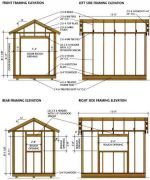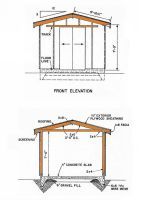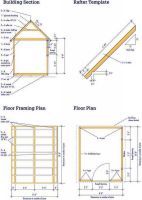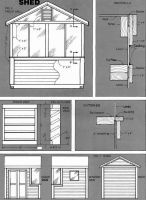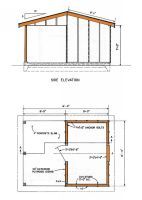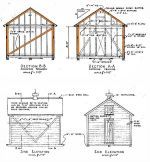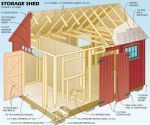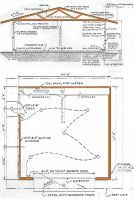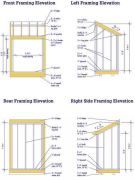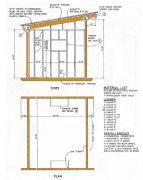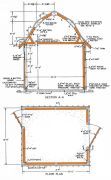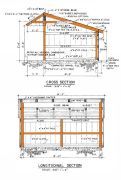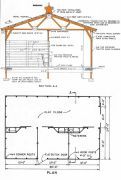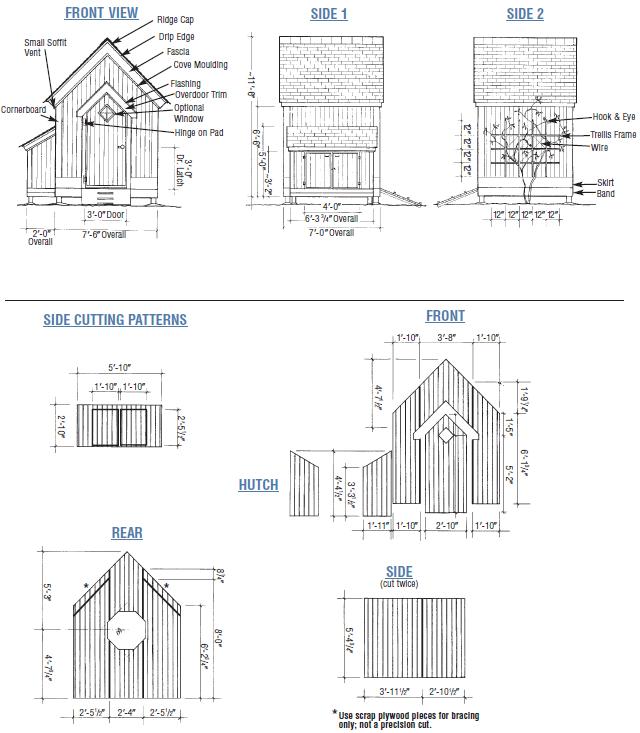
Here are the garden shed plans for a sturdy shed which will be an attractive addition to your home for many years. It has
- approximately 40 square feet of floor space inside the shed
- ample headroom for storage of bicycles, a lawnmower, garden tools or play equipment
- is large enough for a six foot potting bench or workbench
- has a rear window provides natural light
- includes a hutch on the side big enough for several refuse or recycling bins
You can add insulation, electricity, or running water to these storage shed plans and expand the use of this room for many purposes.
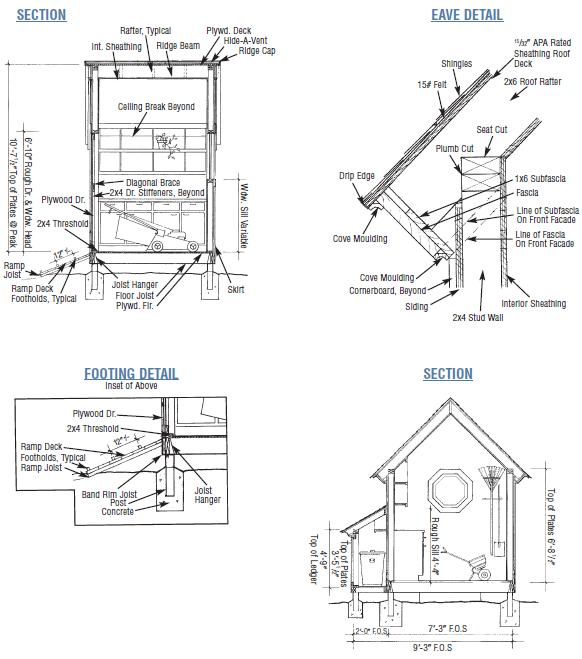
Garden Shed Plans and Blueprints for Constructing A Beautiful Garden Shed
1.SITING THE SHED
- Choose a convenient location, (not necessarily on flat ground).
- When finished, the bottoms of the floor joists should be at least 6 inches above the ground, high enough that water puddling on the ground cannot reach them.
- The ramp should be long enough to slope down at a 45 degree angle or less.
2. FOOTING AND POSTS
- Lay out the holes to make certain they are square. Dig the holes for the footings; the depth should be below your local frost line.
- Make the holes larger than the posts to allow for adjustment (approx. 12“ wide).
- Set four full-length 4 x 4 corner posts in the holes, temporarily bracing them in both directions so they stay plumb. DO NOT pour the concrete.
- The posts for the hutch should be set after the shed is framed.
3. FRAMING
- Hang the rim joists on the posts with joist hangers so the outside faces are flush. Hang the floor joists from the side rim joists using joist hangers at 16” on center or less. Deck the floor with 23/32 “ plywood as shown in the crafting blueprints for making the shed.
- Frame the stud walls horizontally on flat ground using standard construction techniques including a sole plate, a single top plate, and studs at 16” on center.
- Frame the door and window openings of the shed leaving the sole plate under the door.
- Add a nailing surface if you will be adding interior sheathing. Nail the walls in place between the 4 x 4 posts using 16 d sinkers.
- Check the posts to be sure they are plumb and level, and then fill each posthole with 2 bags of concrete, leaving the top surface sloped to drain water away from the posts.
- When the concrete has set thoroughly, cut the four posts off flush with the side wall plate.
- Add a second top plate on top of the side walls extending over the post tops.
- Add a second top plate on top of the front and rear walls lapping the opposite way over the peaks.
4. RIDGE AND RAFTERS
- Toenail the ridge beam in place between the front and rear walls.
- Cut the rafter birdsmouths so the level (seat) cuts are 31/2 “ long where they sit on the top plate.
- The plumb cuts are perpendicular to the seat cuts as shown in the garden shed plans. Let the rafter tails run wild (long) to be trimmed later.
- Lay out the rafter spacing on the ridge using five rafters evenly spaced on each side as shown in the diagram of the garden shed plans.
5. SIDING
- Wrap the entire structure with tar paper or building wrap.
- Nail band to rim joists, and skirt above band to stud walls.
- Before cutting the siding, lay out the cutting lines on the plywood following the enclosed patterns so that the grooves do not fall on a cornerboard and so the center of the facade is centered between two grooves.
- Slip the flashing for the shed roof and overdoor trim under the siding before nailing it to the studs, and Z-flashing under the bottom of the siding and over the skirts.
6. ROOF
- To calculate the rafter tail length mock-up the fascias on the front facade following the dotted lines in the detail drawing provided.
- Cut the rafter tails so that the fascias will neatly wrap around the building corners.
- The grooves in the siding meet the sub-fascia allowing the roof to vent. Sheath the roof with 15/32 “Sheathing. Apply the roof felt and shingles following manufacturer’s instructions. Cover the ridge with ridge vent.
7. DOOR AND WINDOW
- Cut the door out of siding and apply 2 x 4’s flat for stiffening and add a diagonal brace from top hinge down to the lower corner on the swinging side.
- Optional: Add a small window made of plexiglass,window glass or insect screen trimmed with small-dimensioned window stop and use small strips of lattice for decorative muntins.
- Hang the door in the cased opening using decorative strap hinges mounted on pads so they lay flat with the door trim. Leave the sole plate under the door as a door stop. Install window in rear wall.
8. TRIM
- Apply the sub-fascia & fascia on top of the siding. Apply cove moulding to trim the bottom and top edges.
- Add a drip edge at the top of the fascias under the roof deck. Next cut the cornerboards to fit between the skirts and fascias.
- Add the cornerboards to the front and rear facades, then butt the side cornerboards to them so the caulk joint does not show from the main facades.
- Add the door and window casing and the overdoor and overwindow trim.
- Add the drip edge to the side and top edges of the overdoor and overwindow trim.
9. RAMP
- Make the ramp from 2 x 6 pressure treated joists with 5/4 x 6 decking nailed on top. Make it long enough that it slopes down at less than a 45 degree angle.
- Optional: If your ramp is long or steep apply footholds at 12” intervals or at whatever distance is comfortable for your stride and the angle you have chosen; be sure you can get your lawnmower (large shed plans) or other equipment easily around the footholds.
- If you are using the shed for bicycles or a wheelbarrow, two sets of footholds with a space in between for the wheel would be convenient.
10. INTERIOR
- Finish the interior to suit your planned use of the shed. Insulation and Plytanium Ply-Bead Panels will make it cozy and finished. GP perforated hardboard will make it functional for tool storage.
- Shelves and cabinets will be useful for a potting shed if there is water available nearby.
- A serious gardener may want a large sink.
- A workbench and power source will make a functional workshop.
11. TRELLIS
- Lay out the 2 x 2 lattice work as shown in the elevation drawing.
- Where two boards overlap mark the overlaps on both boards with a pencil line.
- Cut and chisel out half the depth of the wood between the pencil lines to make half-lap joints and reassemble the layout with the boards lapped together.
- Use vinyl-coated electrical wire to form support for your plants by weaving it between the boards.
- When you are satisfied with the pattern, screw joints together.
- Hang the trellis from screw eyes with hooks to make it easy to demount for fall cleanup and to repaint the wall behind it without uprooting your plantings.
12. PAINT
Caulk joints carefully except where the siding meets the soffit. Paint or opaque stain the shed to suit your style preference.
13. RECYCLING HUTCH
The hutch is built using the same construction techniques and sequence as the shed except that a ledger board attaches it to the shed much as a deck is attached to a house.
Cut the remaining 8” 4 x 4 posts in half to make the two corner posts. Add flashing where the roof meets the shed siding.





